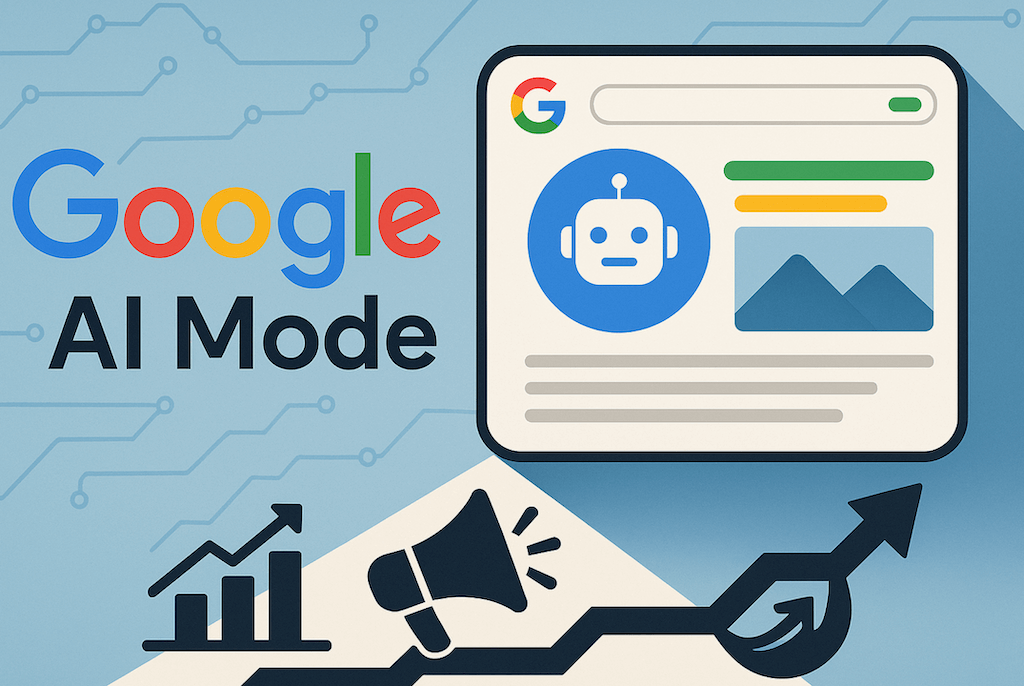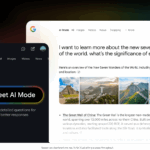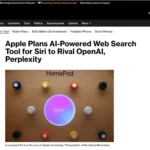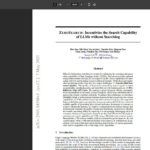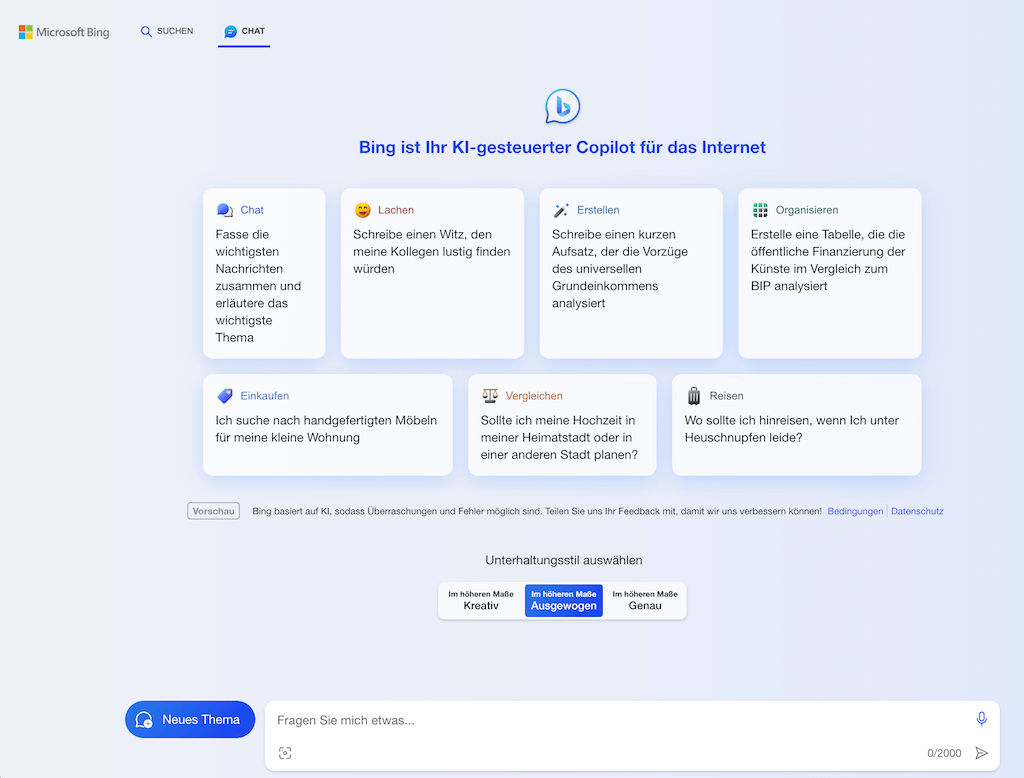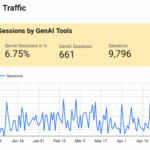With the AI Mode announced at Google I/O 2025, Google will become the AI search engine with the largest reach worldwide. Here you can find out what this means for marketing and how you should react.
What is Google AI Mode? Why will it completely change marketing?
The search engine world is about to undergo a huge upheaval: in the keynote speech at the Google I/O 2025 developer conference, Google CEO Sundar Pichai announced AI Mode for Google Search. Google is thus transforming its classic search engine into an AI-supported answer engine, similar to ChatGPT, Perplexity and co. but with significantly more reach. For digital marketing, this means new rules of the game, new opportunities – but also new challenges. In this article, you’ll find out what’s changing and get specific tips on how to future-proof your marketing now.
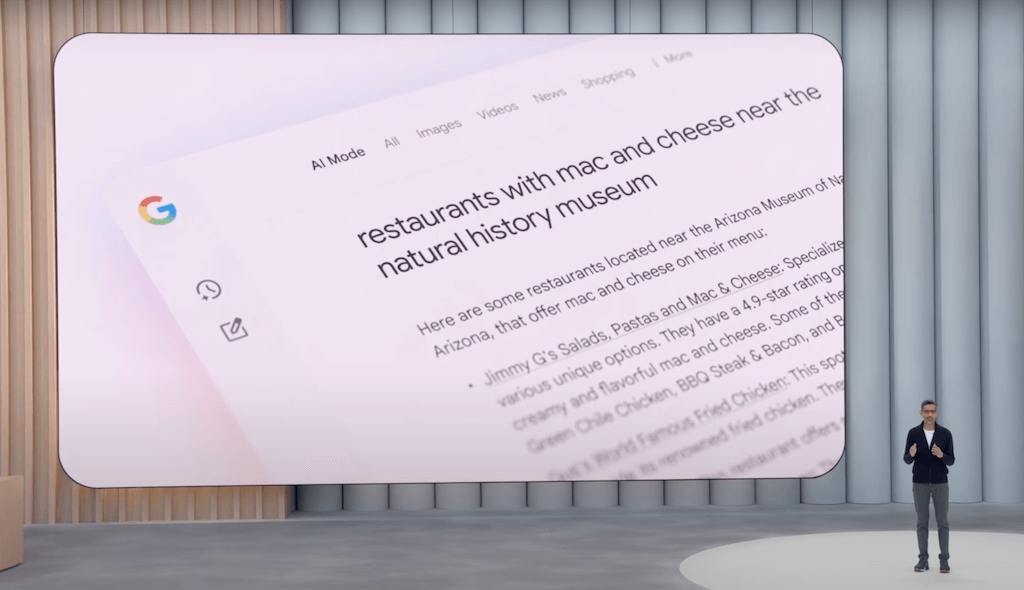
1. Google search will soon only provide answers instead of lists of links – How to optimize your content
AI search engines no longer just provide a list of links, but directly curated, detailed answers to complex questions. Users receive summaries, recommendations, images or even concrete options for action (e.g. buy tickets, book appointments). Traditional SEO strategies such as keyword optimization, headlines/titles/meta descriptions and content clusters aimed at ranking individual pages are becoming less important – instead, the content is quoted directly in AI answers or is likely to be processed without citing sources.
Approaches to optimization
Content optimization for AI answers: Create precise, thematically comprehensive and easy-to-understand content. Use structured data, clear headings and short paragraphs to make it easier for the AI to recognize and use your content.
- Example: Write FAQ sections about your products that answer typical user questions.
Offer exclusive information: Rely on your own analysis, studies or insights that no one else provides. AI prefers original content to mere summaries. Don’t just let AI-generated content be written for you, but create something meaningful that is loved by the AIs and admired by your competitors. If you have this under control, you will also make the leap to the top of the AI responses
- Example: Publish your own industry data or expert interviews.
Strengthen visibility: Build authority through social media presence to build mentions, backlinks and trade media. The more often your brand is mentioned as trustworthy, the more likely it is to be used as a source by AI.
- Example: Work with influencers or media collaborations.
- Example: Create posts on YouTube and Reddit. Video content is more important than ever. Reddit is a reliable source for AI searches, providing new, detailed, and unfiltered information that is created directly by users. If users discuss your products to be marketed on Reddit, the chances increase that this information will appear in AI results. Content moderation and fact-checking play a crucial role in this process.
Use multimedia content: Integrate images, videos and infographics, as AI searches are becoming increasingly multimodal.
- Example: Create explanatory videos on frequently asked questions or use Google Lens-optimized images.
- Example: Show charts, graphs, tables and videos. Isn’t that too excessive and expensive? No, because these can now be created much more easily with AI. See: Create videos with AI
Keep content up to date: Always keep your content up to date, as AI systems prefer to incorporate fresh and relevant information.
- Example: Update product pages immediately when there are changes or new features.
2. Make the content fit for AI searches
Content must be more structured, fact-rich and clearly prepared than before so that it can be recognized, understood and cited by AI. High-quality content such as detailed guides are becoming increasingly important. Headlines, lists and precise information are becoming mandatory. Anyone who is recognized by the AI as a trustworthy source will benefit.
Approaches to optimization
Semantic optimization: Write for topics and contexts, not just keywords. AI understands complex issues better and looks for depth of content. So no more superficial articles, but real, concrete tips written by experts. If you don’t invest any effort in content, you won’t appear in free AI searches and will have to spend money on ads or live with fewer new customers.
- Example: Focus on helpful how-to articles. Not new in the SEO sector, but rarely commissioned by agency clients.
- Example: Analyze what questions and goals your target group has and answer them specifically. Develop content clusters (i.e. series of articles covering EVERYTHING) on common pain points of your customers.
Vary content formats: Offer different formats such as checklists, instructions or expert opinions.
- Example: Offer helpful graphics, checklists, calculators and more on product pages and landing pages.
- Example: Add infographics or podcasts to blog articles.
Incorporate interactive elements: Use tools, calculators or quizzes that offer users real added value and can be recognized by the AI.
- Example: Offer an interactive product finder.
3. More personalization and context
The search is more personalized: Users can give AI access to personal data (e.g. Gmail, calendar) to get even more individualized results. Marketing must therefore focus even more specifically on target groups and their individual needs.
Approaches to optimization
Address target groups individually: Don’t just use one landing page for all target groups. Create new touchpoints for important target groups and optimize them. Provide a lot of information depending on the target group’s life situation.
- Example: Create landing pages for each target group, e.g. young people, people interested in ecology, high earners, singles, couples, children and more
- Example: Young people with little money need information on how they can afford your offer (e.g. financing). Employees will be grateful if you provide tips on how to get around the city on your e-scooter and where to recharge.
No more SEA landing pages: Don’t differentiate between SEA and SEO landing pages, but standardize your web presence and address all target groups there. SEA landing pages are not interesting enough for AI search engines, as the same information is shown here separately from the actual website and is often technically hidden from search engines so as not to incur a duplicate content penalty. Fortunately, this will soon be outdated.
- Example: Integrate your SEA landing page content on the website. Not hidden, but usefully integrated in content blocks, dynamically expandable FAQs, target group subpages, linked in the navigation and more.
Use dynamic content: Rely on dynamic website elements such as tabbed content blocks (=content sections with clickable tab navigation) that adapt according to user behavior. This allows you to create really good pages that help users instead of lots of individual pages.
- Example: Show different offers for existing and new customers on your homepage. Both new and existing customers keep coming back to the website and need interesting offers depending on the situation, e.g. instructions, guides, calculators, etc.
Local optimization: Optimize for local search queries such as “liability insurance Hamburg” and Google My Business searches, e.g. for branches. Google wants to lead users directly to their destination via Google Maps instead of just showing articles. To achieve this, addresses must be findable and up to date so that users are not faced with closed doors. Google’s AI will recognize incorrect results and delete them from the AI results.
- Example: Maintain opening hours, reviews and local offers in your Google profile.
4. Use new advertising formats for AI searches
Ads are integrated differently in AI searches: Instead of classic ads next to the search results, they appear as part of the AI answers or in special info boxes. Advertisers need to test new formats and placements, e.g. sponsored recommendations within AI overviews, to ensure visibility.
Approaches to optimization
Ensure measurability: Measure how many AI-based searches lead to your website and how users behave there. Users will be much more pre-informed about many topics through AI searches. After the AI search, users need clear, confirmatory information on the website. This can be measured and improved.
- Example: Use Sistrix to analyze how often your brand appears in AI overviews.
- Example: Measure your AI traffic on the website
Test AI-supported ad formats: AI searches will lead to new advertising formats. Use new Google Ads formats such as AI Overviews Ads or Performance Max. Use and create your own ad formats that integrate seamlessly with AI responses. Offer exclusive deals that are displayed directly in AI Overviews. Continuously experiment with new formats and channels. Test beta features of Google Ads or new AI partners.
- Example: Create targeted campaigns for products that frequently appear in AI overviews.
- Example: Automatically create different ad variants with AI.
5. AI agents and automation
Google is planning for AI agents to take over tasks such as ticket bookings, price alerts, purchase recommendations or appointments directly. This opens up new touchpoints in the funnel, for example through “buy for me” functions or automated service offers. The easier you make it for your visitors, the more likely they are to complete a purchase.
Approaches for optimization
Chatbots for information: Help users with all their questions through chatbots and hotlines. AI agents will prefer providers that are available on all channels instead of just offering website texts and forms.
- Example: Offer an AI chatbot on your website. But please don’t place it in the bottom corner as an icon, but directly and helpfully in the central content.
- Example: Display the hotline telephone number transparently. AI searches will lead users to pages where they can find the best solution. AI agents will also be able to call hotlines themselves to arrange an appointment for the users searching. Those who do not want or cannot establish direct contact with their users will be at a disadvantage here.
Using voice agents to book appointments: Meanwhile, AI voice agents like ElevenLabs really already sound very real and can perform simple tasks such as making an appointment with the user independently. This makes it easy for users to make an appointment and clarify simple questions without having to wait on hold.
- Example: Offer a callback via AI agent to arrange an appointment instead of the usual callback service. In future, users will be increasingly open to being able to complete simple tasks with AI agents.
Conclusion: Adapt marketing for AI searches in good time
The AI revolution in search is fundamentally changing the rules of the game in marketing through Google and AI Mode. Those who focus on high-quality, structured content, personalization and innovative advertising formats early on will remain visible and relevant. Use the new opportunities to establish your brand as a trustworthy source and take full advantage of the opportunities offered by the AI search world!
Now is the ideal time to review your marketing strategy and optimize it specifically for the AI era.

